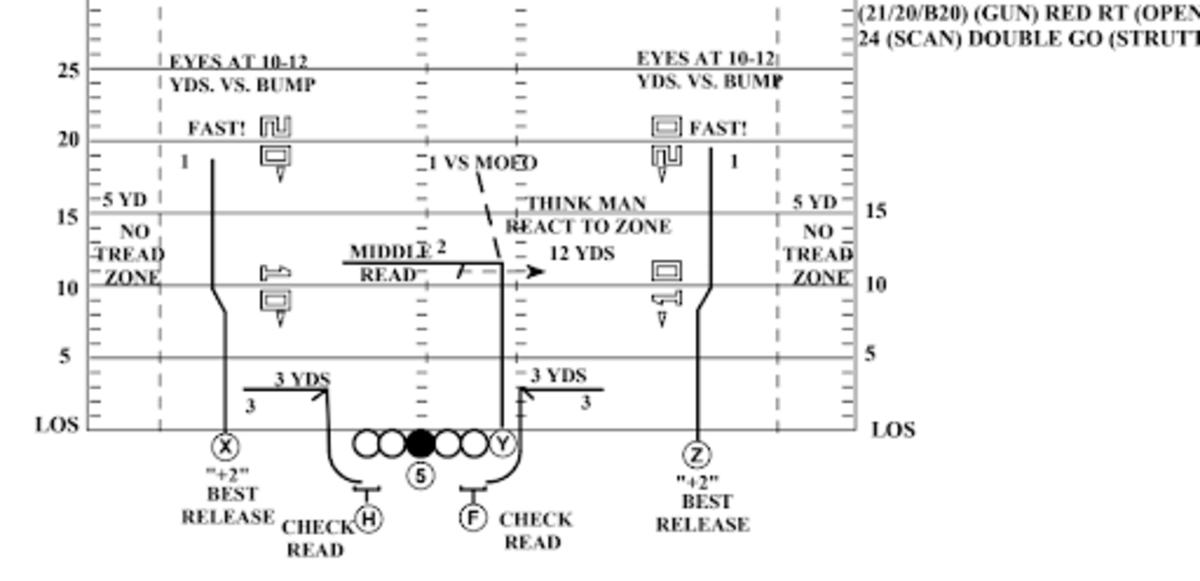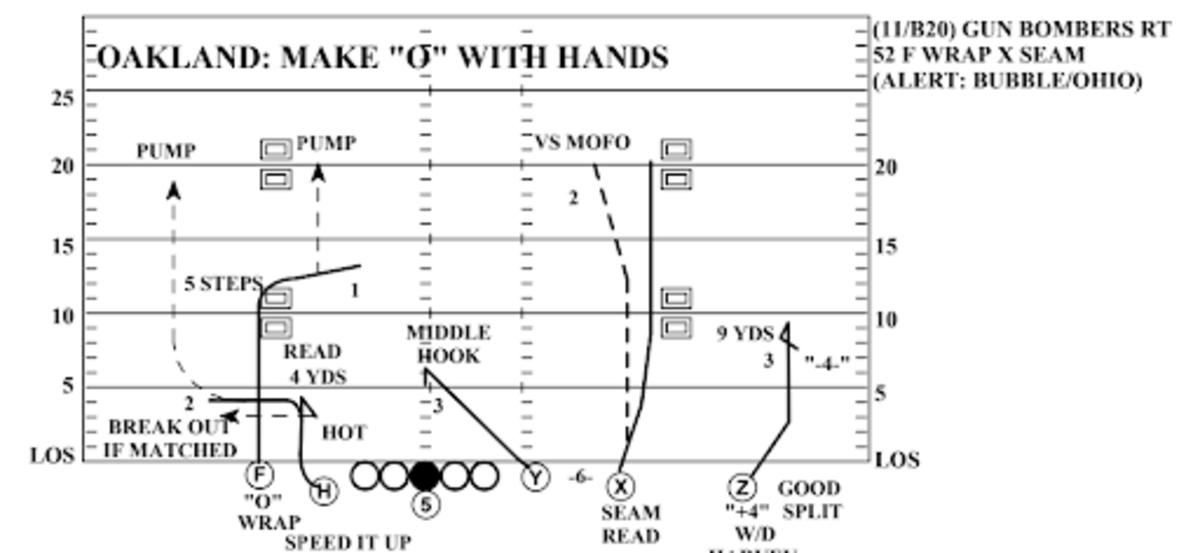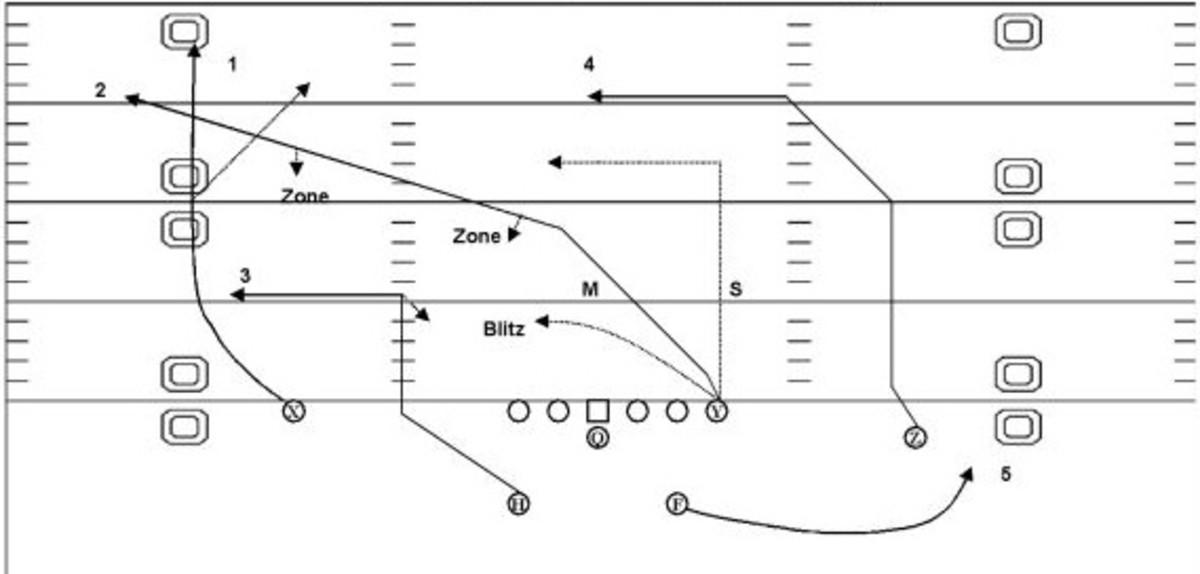Film Breakdown: Empty Sets and the Key Passing Concepts the Bengals Should Utilize Going Forward
The Bengals are coming off of a 20-17 loss to the Bears. While the game had a negative result, there are still positives to be found within it.
There have been a few passing concepts that the Bengals have used this year that should be part of their future game plans. These are designs that are either working very well, utilize a player's skill set perfectly, or sometimes both. On the other end, the Bengals have made life difficult with their pass protection. Let’s look into what the Bengals did in Chicago, including what they should and should not bring into this week's matchup against Pittsburgh.
Key Passing Concepts

Joe Burrow and Ja'Marr Chase used the 989 passing concept when they were at LSU. This hasn't changed as both of Chase's long touchdowns came off of the concept.
It's essentially two go routes on the outside with a basic/post option from the slot. Also commonly called "double go," it's a concept that the Bengals are currently in when they want to take a shot from the dropback passing game. The option for the basic (10-12 yard in) and the post comes from whether the defense is in a "middle of the field closed" or "middle of the field open" look, which is what it sounds like.
In Cover 3 and Cover 1, there is a safety in the middle of the field. Running a post route would just be running straight into the defender. Conversely, against middle of the field open, (basically Cover 2, Quarters, 2-man, and other variations) there is a hole between the two safeties for a throw. Also, the post route will attack some quarters rules better by being a more vertical route. The go routes come from whatever the "best release" is which means that the wide receiver has the freedom to release however they see fit. Typically it is an outside release, but against the Bears, Chase used an inside release instead and scored a touchdown. The quarterback typically picks a matchup for the go routes then reads that match up to the basic/post. Check downs after that. This concept is good against most coverages to take a shot downfield, the main issue comes in protecting it.
Look at the difference with this pocket as the Bengals use both Mixon and Uzomah to chip from empty.
— mike (@bengals_sans) September 21, 2021
Bengals run 989 and Burrow has a clean platform to launch this deep ball. Great job from Chase to sell outside before working inside on the go route. pic.twitter.com/xRPNcxwTaf
Chase starts his release to the outside against the corner's outside leverage. This softens him up even more to the inside and allows Chase to put the corner on his heels a bit. The corner cannot let him get into his blind spot, so he has to really work to stay outside and on top of this route. When Chase then cuts inside to start the go route, he has the corner spinning and grasping at him. This creates plenty of separation for the go ball. Burrow seems to underthrow this one, but Chase does a really nice job to keep selling vertically before coming inside and catching the ball. This gets the corner and the safety to crash into each other. Chase has a walk-in touchdown as a result.
Ja'Marr Chase gets wide open behind Jaylon Johnson. Burrow just missed him. pic.twitter.com/adBpx4B6mE
— mike (@bengals_sans) September 21, 2021
Earlier on the same drive, the Bengals called up double go again. Chase gets wide open in Jaylon Johnson's blind spot, but Burrow misfires again and puts this ball out of bounds. Really awesome job from Chase though to quickly shift and get to Johnson's blind spot while downfield. I think the go route is right up Chase’s alley. He was fantastic running it in college and that has stayed true in the NFL.

The next concept is called race or wrap. This is the 2-man concept to the left side of the image with a whip/sit option route inside and underneath a dig route from the outside receiver. This is another concept that was commonly used by Burrow at LSU. The idea of this concept is to Hi-Lo the second-level defenders in zone or win leverage against man. In zone, the curl defenders in the middle of the field will have to play against both the dig and the whip. The quarterback just throws it off of what the defender does. Against man, the dig is typically a good route to run. Even if that is covered, the whip is a common man beating route as well.
Here we get the race concept (whip and dig) from Boyd and Higgins from empty. Burrow hits the dig route to Tee despite pressure up the middle. Then fumble. pic.twitter.com/WciOo46a3k
— mike (@bengals_sans) September 21, 2021
The Bears bring a 5-man pressure on this play. The Bengals are in empty and are using the race/wrap concept on the left side from the two inner receivers. The whip underneath clears the defender out of the way while the defender against Tee Higgins is playing with outside leverage. This means that the dig is going to be wide open when Higgins breaks to the inside. Burrow hits the dig and it should be a nice gain, but then Eddie Jackson forces a fumble and the Bengals turn the ball over.
Everything prior to the fumble was really solid football. A good gain with a guy running free in space is something the offense will take on any play.
Bengals run the race concept again. This time it's from bunch and Burrow throws the whip route to Tyler Boyd. Big play. pic.twitter.com/nGzPiUl8jA
— mike (@bengals_sans) September 21, 2021
Another example of race, but the Bengals dress it up differently this time. They run it from a bunch set. The defense is playing weak rotation Cover 3 buzz. The buzz safety is closing in on the window of the dig, so Burrow throws the whip to Tyler Boyd who is wide open.
Boyd runs after the catch to turn it into a big gain. Really nice example of when to hit the whip route and the offense doing so successfully. The whip route is a really nice route to use with Boyd due to his quick change of direction and ability to set up the defenders. I also think Higgins is a good player to run the dig with because of his strength and ability to catch the ball through contact.

This concept is a one man concept, which is really just a very complicated route. The juke route was made famous by the New England Patriots over the past two decades. It’s an option route with 3 possibilities. Sitting or working to either of the horizontals based on the coverage.
The Tyler Boyd juke route is so disgusting. Unguaradble by underneath defenders. pic.twitter.com/suw7WT7dUA
— mike (@bengals_sans) September 21, 2021
Boyd is running the juke route on this play. He really sells the sit portion of the route to get the linebacker to screaming downhill at him. Once he sits for half of a second, he gives a little bit of a shimmy before working inside.
Burrow is getting hit during the throw, but still gets this ball off to him. Only a 5-yard gain or so due to the throw (understandably) being slightly off. If Burrow is not hit this could have been closer to a 10-yard gain with Boyd’s strong running style. Still, he was able to work the underneath defenders on this play. This play is exactly what Cincinnati should be doing with Boyd. Put him in a position to set up underneath and create space for himself.

Here is Y-cross, which is a concept mainly focused on the crossing route from the Y in this case. In the Bengals case, they seem to like to run that crossing route with Boyd, the slot receiver. Plenty of places to sit for him against zone and there are a lot of options on this play for the quarterback. The go route from the X is really just an alert in case the defenders do a terrible job covering it. The cross is the next step in the progression which creates somewhat of a hi-lo read with the out route from the H. If neither of those are open, the backside dig route is next, but that is a throw the quarterback rarely makes.
Bengals running Y insert play action. I like the cross concept coming from the slot behind it. Perfectly between the linebackers and safeties. pic.twitter.com/xpNR1ybs5E
— mike (@bengals_sans) September 21, 2021
Here is the Bengals' variation of cross, starting with insert play action rather than a straight drop back. Outside of the play action, it is the same idea everywhere else. The play action is nice because it sucks the linebackers in a little bit, which gives Boyd more room on the cross route. Due to the safeties playing only 20 yards deep and the linebackers being drawn in, Boyd runs his cross at about 10 yards of depth. The point for him is to get in that sweet spot between the linebackers and safeties. Burrow throws an accurate pass for a nice gain and it moves the sticks.
All of these are concepts that I would incorporate in the offense moving forward. Maybe dress them up differently with multiple formations and play action looks to get to these plays, but they are solid concepts that for the most part Burrow has been running since his LSU days.
They don't need to have five players in the route either, so the backs and tight ends can help with pass protection. They should not get too predictable because every play has a counter for the defense, but if the offense can switch things up enough these ideas should help to generate a ton of offense in the future.
Empty Protection
Empty in theory is something that can be utilized to get as many playmakers in space as possible. There are positives to employing it, especially from heavier personnel groupings. It makes the defense easier to read and if you have the quarterback for it, the defense could get shredded by quick passing concepts. With tight ends and backs split out wide, the man-zone indicators become easy. Look to see who is over those players. If a corner is lined up over a back or tight end, it is most likely zone coverage.
On the flip side, if a linebacker or safety is lined up over those players, it is most likely man coverage. Of course, the quarterback should try to confirm this post-snap as well, but it does eliminate some doubt about the coverage being faced. Empty also allows for there to be up to 3 guys inside and off of the line of scrimmage. Essentially slot wide receiver positions. This allows for free releases off of the line of scrimmage and for these players to work horizontally more with the extra room.
As there are with most things in football, there are drawbacks to working out of empty as well. There is no real threat of a run game or play action from empty. Play action passes are a staple of the modern NFL offense because of the ability to mess with second level defenders' keys and the need to fit the run. Without the threat of a run game, these players are able to drop into their zones or play their man without hesitation.
The ball also has to come out quickly in empty. At best on a 4-man rush the offense will be stuck with three one-on-one blocks. Unless the offensive line is a full tier above the defenders they are facing, these blocks can only be trusted for so long. This leads to a lot of quick game from empty so that the defenders do not get a chance to win their battle.
Sack #2!
— mike (@bengals_sans) September 20, 2021
I'd put this one mostly on Burrow/the receivers. OL holds up for about 4 seconds. Can't see anything downfield because broadcast sucks, but in empty that ball has to come out within those 4 seconds. Burrow should either bail and create or throw it up downfield. pic.twitter.com/MZv5qNGPem
The play call deserves a big part of the blame for this sack, but the receivers, and Burrow also share blame for not getting the ball out quick enough. That's partly because the Bengals being in empty which leads to all of those one-on-one blocks. Eventually, those blocks wear down and the protection collapses. If there was another player along the line to help out, the defense most likely is not bearing down on the quarterback as quickly.
With only five guys on the offensive line, the protections can be manipulated easier. By simply covering every offensive lineman, the defense can get what is called a 5-0 or “big on big” protection. The offensive line will man everything with one on ones to the guy covering them. This can let the defense isolate a matchup that they like.
Sack #4
— mike (@bengals_sans) September 20, 2021
Bears get the OL to slide left by bluffing a linebacker onto the line of scrimmage.
Bears then drop both the end and that LB onto coverage while blitzing a LB from the other side. Reiff gets stuck on his man and Burrow never sees the free rusher. pic.twitter.com/x7Ue7sd49A
Another way they can mess with the offensive line is to overload one side to get the slide going in that direction. This can take advantage of the offense by either bringing someone off of the opposite end or by exploiting a one on one matchup with the defender's best player. On this play, the Bears exploit it by bringing someone off of the opposite edge. Reiff faces a 2-on-1 situation and allows the end to go free. The Bears only brought 4 so Reiff could have passed off his guy and worked to the blitz off of the edge, but is unable to do so.
Due to these drawbacks in empty, the Bengals should probably utilize it less going forward. It is not something that they should completely scrap because I think Burrow does a great job playing in it. He processes things quickly, excels in the quick game, and has some ability to make things happen with improvisation after the play breaks down. However, being in empty for more than a few snaps per game really makes life difficult on both the offensive line and the quarterback.
The quarterback doesn’t get the easy plays from play action or the big plays from deep drops. The offensive line is trying to play without help and is forced to pass block on every snap.
This could become a big issue against Pittsburgh. If they are trying to solo block 75% of Cam Heyward, T.J. Watt, Alex Highsmith, and Melvin Ingram. Those are four very good players and I am sure the offensive line would not mind some help from a back or tight end against them. If the coaching staff believes that empty is the key to a successful game or if Burrow feels most comfortable when playing in empty there are ways to still help out the protection.
Leaving a tight end attached to the line would allow them to protect with six rather than five. This allows for deeper passes and for the offensive line to have an easier day. In fact, if you rewatch the Chase touchdown towards the beginning of this article you will see that the Bengals already started to utilize six and 7-man protections from empty. This gives me hope that the coaching staff sees the issue in their empty sets and has already figured out a correction.
Make sure you bookmark All Bengals for the latest news, exclusive interviews, film breakdowns and so much more with the season opener just a few days away!
You May Also Like:
Injury Updates: Tee Higgins, Xavier Su'a-Filo and Trae Waynes
Bengals Rookie Ja'Marr Chase Off to Record-Setting Start This Season
Zac Taylor Worried About Hits, Not Sacks That Joe Burrow is Taking
Bengals Add Familiar Face in Offensive Line Room
Trae Waynes Working Out, Hoping to Return From Injured Hamstring
Bengals Open as Underdogs to Steelers in Week 3
Dave Lapham Weighs in on the State of the Offensive Line
Three Down Look: Bengals Flop Against Bears in Windy City
Randy Moss Says He's Still Got it: 'I'll Score a Touchdown on These Fools"
T.J. Watt Could Play Against Bengals Despite Groin Injury
Four Takeaways From the Bengals' Loss to the Bears
Snap Count Breakdown From Cincinnati's 20-17 Loss to Chicago
Joe Burrow and Ja'Marr Chase Offer Solution to Struggles on Offense
Joe Mixon Vows to be Better Following Loss to Bears
Winners and Losers from the Bengals' 20-17 Loss to Chicago
Postgame Observations: Bengals Lose to Bears 20-17
-----
Be sure to keep it locked on All Bengals all the time!
Subscribe to the All Bengals YouTube channel
Follow AllBengals on Twitter: @AllBengals
